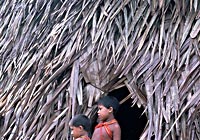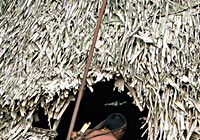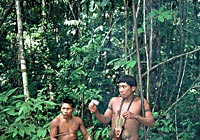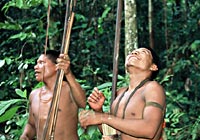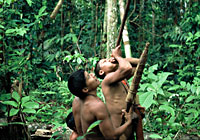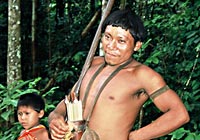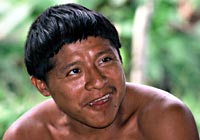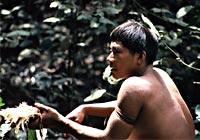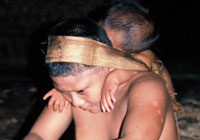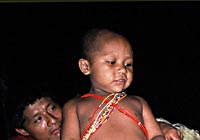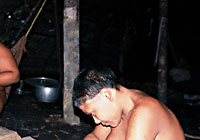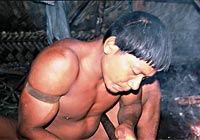
|
|
|
Korubo IndiansThe Caceteiros (Head-Bashers)The Korubo Indians are the last unknown tribe to be contacted in the Amazon. They first made contact in 1996. The Korubo tribe is known locally in Brazil as the Caceteiros which literally means "clubber" in Portuguese. Subsequently, they because known as the "Head-Bashers" in the popular press. These native Amazonians received this name because they carry war clubs that they use to fight with in battle. Unfortunately for the Brazilian government's FUNAI (Fundação Nacional do Índio), seven of their members have been clubbed to death by members of the Korubo tribe. Surprisingly, the FUNAI has not sought to capture or reprimand the individuals involved, saying that these indigenous Amazonians did not know about Brazilian laws that prohibits killings such as these and therefore could not be prosecuted. The Korubos call themselves the Dslala. They speak a language in the Pano linguistic family that is closely related to the Northern Pano dialects that the Matis and Mayoruna-Matses Indians speak. However, unlike other tribes that live in the Javari River Valley such as the Matis, Mayoruna-Matses, and Marubos, they do not tattoo their faces. However, they are readily distinguishable by their characteristic haircut, which is closely cropped in back and longer in the front. Most of the Korubos are still uncontacted and most of what we know about them comes from contact with a small group that lives near the FUNAI outpost at the confluence of the Itui and Itaquai Rivers in the Javari River Valley of Brazil. The reported leader of this group is a woman called "Maya" who is seen in some of the above photos. Incredibly, Maya was reported to have been involved in the killing of a Brazilian government FUNAI official. According to reports, the FUNAI officials asked Maya and the Korubos to return a tarp that they had borrowed. Maya helped lure the FUNAI officials with smiles to an area where other Korubos were waiting to ambush them. She then helped hold the arms of one the victims (Raimundo Batista) as other Korubos used war clubs to bash him in the head and kill him. The Korubo warrior who killed Batista is named Ta’van. Later, Ta’van offered a reason for his killing Batista, saying that, “We didn’t know you then.” Like other tribes in the Javari River Valley such as the Mayoruna-Matses, the Korubo Indians practice infanticide. When a child is born with a birth defect such as a cleft palate, the baby is killed. Unfortunately, cleft palate is often frequent in Amazonian Indian populations due to inbreeding. Even older Korubo children are sometimes sacrificed. For example, Maya killed one of her own daughters when she was ill with malaria. She said that she killed her because she was afraid the disease would spread to others. As one might suspect, the Korubos themselves have been frequent victims of other tribes in the region. For example, the mother of Bina Tucu Matis (the secondary chief of the Matis tribe) was Korubo. Bina's Korubo mother was kidnapped by the Matis tribe and her family was killed during the ambush. Assimilation of women and children from other tribes was common in the Javari River Valley, and some tribes such as the Mayoruna-Matses actually had more members who were born outside of the tribe (being kidnapped and assimilated) than those that were born into it.
Typically the Korubo are blowgun hunters rather than bow and arrow hunters.
Blowgun hunters usually do not readily switch over to shotguns as do bow and
arrow hunters. This probably has to do with the higher rate of hunting
success with blowguns and the high expense of shotgun cartridges. At
present, the Korubos have few shotguns and primarily use blowguns to
hunt. Although primarily being hunter-gatherers, they also practice
horticulture and cultivate crops typical of the Amazon such as manioc, plantains
and maize.
|
|
|
